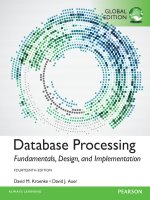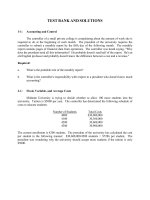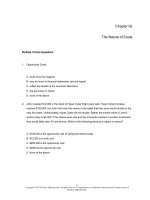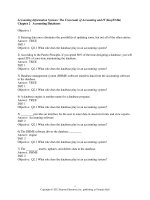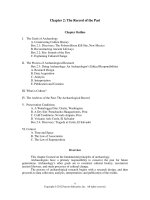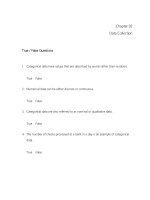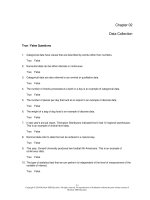Database processing fundamentals design and implementation 14th edition kroenke test bank
Bạn đang xem bản rút gọn của tài liệu. Xem và tải ngay bản đầy đủ của tài liệu tại đây (220.21 KB, 33 trang )
Database Processing, 14e (Kroenke)
Chapter 2: Introduction to Structured Query Language
1) Business Intelligence (BI) systems typically store their data in data warehouses.
Answer: TRUE
AACSB: Information Technology
Difficulty: Easy
LO: To understand the use of extracted data sets in business intelligence (BI) systems
Classification: Concept
2) An ad-hoc SQL query is typically written within an application program.
Answer: FALSE
AACSB: Information Technology
Difficulty: Moderate
LO: To understand the use of ad-hoc queries in business intelligence (BI) systems
Classification: Concept
3) SQL stands for Standard Query Language.
Answer: FALSE
AACSB: Information Technology
Difficulty: Easy
LO: To understand the history and significance of Structured Query Language (SQL)
Classification: Concept
4) SQL includes a data definition language, a data manipulation language, and SQL/Persistent
stored modules.
Answer: TRUE
AACSB: Information Technology
Difficulty: Moderate
LO: To understand the history and significance of Structured Query Language (SQL)
Classification: Concept
5) SQL is only a data manipulation language (DML).
Answer: FALSE
AACSB: Information Technology
Difficulty: Difficult
LO: To understand the history and significance of Structured Query Language (SQL)
Classification: Concept
6) The American National Standards Institute (ANSI) maintains the standards for SQL.
Answer: TRUE
AACSB: Information Technology
Difficulty: Difficult
LO: To understand the history and significance of Structured Query Language (SQL)
Classification: Concept
1
Copyright © 2016 Pearson Education, Inc.
7) SQL was developed by IBM in the late 1970s.
Answer: TRUE
AACSB: Information Technology
Difficulty: Easy
LO: To understand the history and significance of Structured Query Language (SQL)
Classification: Concept
8) SQL is not a complete programming language. Rather it is a data sublanguage.
Answer: TRUE
AACSB: Information Technology
Difficulty: Moderate
LO: To understand the history and significance of Structured Query Language (SQL)
Classification: Concept
9) In addition to being a data sublanguage, SQL is also a programming language, like Java or C#.
Answer: FALSE
AACSB: Information Technology
Difficulty: Moderate
LO: To understand the history and significance of Structured Query Language (SQL)
Classification: Concept
10) SQL commands can be embedded in application programs.
Answer: TRUE
AACSB: Information Technology
Difficulty: Difficult
LO: To understand the history and significance of Structured Query Language (SQL)
Classification: Concept
11) SQL, although very popular, has never become a national standard.
Answer: FALSE
AACSB: Information Technology
Difficulty: Moderate
LO: To understand the history and significance of Structured Query Language (SQL)
Classification: Concept
12) The SQL keyword SELECT is used to specify the columns to be listed in the query results.
Answer: TRUE
AACSB: Information Technology
Difficulty: Moderate
LO: To understand the SQL SELECT/FROM/WHERE framework as the basis for database
queries
Classification: Concept
2
Copyright © 2016 Pearson Education, Inc.
13) The SQL keyword WHERE is used to specify the table(s) that contain(s) the data to be
retrieved.
Answer: FALSE
AACSB: Information Technology
Difficulty: Easy
LO: To understand the SQL SELECT/FROM/WHERE framework as the basis for database
queries
Classification: Concept
14) The SQL keyword FROM is used to specify the table to be used.
Answer: TRUE
AACSB: Information Technology
Difficulty: Easy
LO: To understand the SQL SELECT/FROM/WHERE framework as the basis for database
queries
Classification: Concept
15) SQL can only query a single table.
Answer: FALSE
AACSB: Information Technology
Difficulty: Moderate
LO: To understand the SQL SELECT/FROM/WHERE framework as the basis for database
queries
Classification: Concept
16) SQL statements end with a colon.
Answer: FALSE
AACSB: Information Technology
Difficulty: Easy
LO: To understand the SQL SELECT/FROM/WHERE framework as the basis for database
queries
Classification: Concept
17) The columns to be obtained by an SQL command are listed after the FROM keyword.
Answer: FALSE
AACSB: Information Technology
Difficulty: Moderate
LO: To understand the SQL SELECT/FROM/WHERE framework as the basis for database
queries
Classification: Concept
18) To remove duplicate rows from the result of a query, specify the SQL DISTINCT keyword.
Answer: TRUE
AACSB: Information Technology
Difficulty: Difficult
LO: To create SQL queries that use the SQL DISTINCT, TOP, and TOP PERCENT keywords
Classification: Concept
3
Copyright © 2016 Pearson Education, Inc.
19) To obtain all columns, use an asterisk (*) wildcard character instead of listing all the column
names.
Answer: TRUE
AACSB: Information Technology
Difficulty: Easy
LO: To understand the SQL SELECT/FROM/WHERE framework as the basis for database
queries
Classification: Concept
20) The SQL WHERE clause contains the condition that specifies which rows are to be selected.
Answer: TRUE
AACSB: Information Technology
Difficulty: Easy
LO: To understand the SQL SELECT/FROM/WHERE framework as the basis for database
queries
Classification: Concept
21) The result of an SQL SELECT operation can contain duplicate rows.
Answer: TRUE
AACSB: Information Technology
Difficulty: Moderate
LO: To understand the SQL SELECT/FROM/WHERE framework as the basis for database
queries
Classification: Concept
22) To have SQL automatically eliminate duplicate rows from a result, use the keyword
DISTINCT with the FROM keyword.
Answer: FALSE
AACSB: Information Technology; Application of Knowledge
Difficulty: Difficult
LO: To create SQL queries that use the SQL DISTINCT, TOP, and TOP PERCENT keywords
Classification: Concept
23) An asterisk (*) following the SELECT verb means that all columns are to be displayed.
Answer: TRUE
AACSB: Information Technology
Difficulty: Moderate
LO: To understand the SQL SELECT/FROM/WHERE framework as the basis for database
queries
Classification: Concept
4
Copyright © 2016 Pearson Education, Inc.
24) The WHERE clause contains the condition that specifies which columns are to be selected.
Answer: FALSE
AACSB: Information Technology
Difficulty: Moderate
LO: To understand the SQL SELECT/FROM/WHERE framework as the basis for database
queries
Classification: Concept
25) The rows of the result table can be sorted by the values in one or more columns.
Answer: TRUE
AACSB: Information Technology
Difficulty: Easy
LO: To create SQL queries that use the SQL SELECT, FROM, WHERE, ORDER BY, GROUP
BY, and HAVING clauses
Classification: Concept
26) Sorting is specified by the use of the SORT BY phrase.
Answer: FALSE
AACSB: Information Technology
Difficulty: Easy
LO: To create SQL queries that use the SQL SELECT, FROM, WHERE, ORDER BY, GROUP
BY, and HAVING clauses
Classification: Concept
27) To sort the rows of the result table, the ORDER BY clause is specified.
Answer: TRUE
AACSB: Information Technology
Difficulty: Moderate
LO: To create SQL queries that use the SQL SELECT, FROM, WHERE, ORDER BY, GROUP
BY, and HAVING clauses
Classification: Concept
28) Columns can be sorted in descending sequence by using the SQL DESC keyword.
Answer: TRUE
AACSB: Information Technology
Difficulty: Moderate
LO: To create SQL queries that use the SQL SELECT, FROM, WHERE, ORDER BY, GROUP
BY, and HAVING clauses
Classification: Concept
29) A WHERE clause can contain only one condition.
Answer: FALSE
AACSB: Information Technology
Difficulty: Easy
LO: To understand the SQL SELECT/FROM/WHERE framework as the basis for database
queries
Classification: Concept
5
Copyright © 2016 Pearson Education, Inc.
30) When two conditions must both be true for the rows to be selected, the conditions are
separated by the SQL AND keyword.
Answer: TRUE
AACSB: Information Technology; Application of Knowledge
Difficulty: Easy
LO: To create SQL queries that use the SQL logical operators including AND, OR, and NOT
Classification: Concept
31) To refer to a set of values needed for a condition, use the SQL IN operator.
Answer: TRUE
AACSB: Information Technology; Application of Knowledge
Difficulty: Difficult
LO: To create SQL queries that use the SQL comparison operators including BETWEEN,
LIKE, IN, and IS NULL
Classification: Concept
32) To exclude one or more values using a condition, the SQL OUT keyword must be used.
Answer: FALSE
AACSB: Information Technology
Difficulty: Difficult
LO: To create SQL queries that use the SQL comparison operators including BETWEEN,
LIKE, IN, and IS NULL
Classification: Concept
33) To refer to a set of values in a condition, the values are placed inside parentheses ( ) and
separated by commas.
Answer: TRUE
AACSB: Information Technology
Difficulty: Difficult
LO: To create SQL queries that use the SQL comparison operators including BETWEEN,
LIKE, IN, and IS NULL
Classification: Concept
34) The condition in WHERE clauses can refer to a set of values by using the IN operator.
Answer: TRUE
AACSB: Information Technology; Application of Knowledge
Difficulty: Moderate
LO: To create SQL queries that use the SQL comparison operators including BETWEEN,
LIKE, IN, and IS NULL
Classification: Concept
6
Copyright © 2016 Pearson Education, Inc.
35) The SQL keyword LIKE is used in SQL expressions to select partial string values.
Answer: TRUE
AACSB: Information Technology; Application of Knowledge
Difficulty: Moderate
LO: To create SQL queries that use the SQL comparison operators including BETWEEN,
LIKE, IN, and IS NULL
Classification: Concept
36) The SQL wildcard character "%" represents a series of one or more unspecified characters.
Answer: FALSE
AACSB: Information Technology; Application of Knowledge
Difficulty: Difficult
LO: To create SQL queries that use the SQL comparison operators including BETWEEN,
LIKE, IN, and IS NULL
Classification: Concept
37) The SQL wildcard character "#" indicates a single, unspecified character in a specific
location in an SQL query.
Answer: FALSE
AACSB: Information Technology
Difficulty: Difficult
LO: To create SQL queries that use the SQL comparison operators including BETWEEN,
LIKE, IN, and IS NULL
Classification: Concept
38) The Microsoft Access wildcard character "*" (asterisk) indicates a sequence of one or more
unspecified characters in a Microsoft Access SQL query.
Answer: FALSE
AACSB: Information Technology; Application of Knowledge
Difficulty: Difficult
LO: To create SQL queries that use the SQL comparison operators including BETWEEN,
LIKE, IN, and IS NULL
Classification: Concept
39) The Microsoft Access wildcard character "_" (underscore) indicates a single, unspecified
character in a specific location in a Microsoft Access SQL query.
Answer: FALSE
AACSB: Information Technology
Difficulty: Difficult
LO: To create SQL queries that use the SQL comparison operators including BETWEEN,
LIKE, IN, and IS NULL
Classification: Concept
7
Copyright © 2016 Pearson Education, Inc.
40) The SQL built-in function ADDUP totals values in numeric columns.
Answer: FALSE
AACSB: Information Technology
Difficulty: Easy
LO: To create SQL queries that use the SQL built-in aggregate functions of SUM, COUNT,
MIN, MAX, and AVG with and without the SQL GROUP BY clause
Classification: Concept
41) The SQL built-in function AVG computes the average of values in numeric columns.
Answer: TRUE
AACSB: Information Technology; Application of Knowledge
Difficulty: Easy
LO: To create SQL queries that use the SQL built-in aggregate functions of SUM, COUNT,
MIN, MAX, and AVG with and without the SQL GROUP BY clause
Classification: Concept
42) The SQL built-in function MOST obtains the largest value in a numeric column.
Answer: FALSE
AACSB: Information Technology
Difficulty: Easy
LO: To create SQL queries that use the SQL built-in aggregate functions of SUM, COUNT,
MIN, MAX, and AVG with and without the SQL GROUP BY clause
Classification: Concept
43) The SQL built-in function MIN obtains the smallest value in a numeric column.
Answer: TRUE
AACSB: Information Technology; Application of Knowledge
Difficulty: Easy
LO: To create SQL queries that use the SQL built-in aggregate functions of SUM, COUNT,
MIN, MAX, and AVG with and without the SQL GROUP BY clause
Classification: Concept
44) The SQL built-in function COUNT computes the number of rows in a query.
Answer: TRUE
AACSB: Information Technology; Application of Knowledge
Difficulty: Easy
LO: To create SQL queries that use the SQL built-in aggregate functions of SUM, COUNT,
MIN, MAX, and AVG with and without the SQL GROUP BY clause
Classification: Concept
45) The built-in function SUM can be used with any column.
Answer: FALSE
AACSB: Information Technology; Application of Knowledge
Difficulty: Moderate
LO: To create SQL queries that use the SQL built-in aggregate functions of SUM, COUNT,
MIN, MAX, and AVG with and without the SQL GROUP BY clause
Classification: Concept
8
Copyright © 2016 Pearson Education, Inc.
46) The clause SELECT COUNT (*) results in a table with a single row and a single column.
Answer: TRUE
AACSB: Information Technology; Application of Knowledge
Difficulty: Moderate
LO: To create SQL queries that use the SQL built-in aggregate functions of SUM, COUNT,
MIN, MAX, and AVG with and without the SQL GROUP BY clause
Classification: Concept
47) Arithmetic in SQL statements is limited to the operations provided by the built-in functions.
Answer: FALSE
AACSB: Information Technology
Difficulty: Easy
LO: To create SQL queries to retrieve data from a single table
Classification: Concept
48) The SQL keyword GROUP BY instructs the DBMS to group together those rows that have
the same value in a column.
Answer: TRUE
AACSB: Information Technology
Difficulty: Easy
LO: To create SQL queries that use the SQL SELECT, FROM, WHERE, ORDER BY, GROUP
BY, and HAVING clauses
Classification: Concept
49) A WHERE clause can contain another SELECT statement enclosed in parentheses.
Answer: TRUE
AACSB: Information Technology; Application of Knowledge
Difficulty: Easy
LO: To create SQL queries that retrieve data from a single table while restricting the data based
upon data in another table (subquery)
Classification: Concept
50) A SELECT statement used in a WHERE clause is called a subquery.
Answer: TRUE
AACSB: Information Technology
Difficulty: Easy
LO: To create SQL queries that retrieve data from a single table while restricting the data based
upon data in another table (subquery)
Classification: Concept
9
Copyright © 2016 Pearson Education, Inc.
51) A nested SELECT statement (one that appears within the WHERE clause of another SQL
statement) is called a subquery and must be enclosed in parentheses.
Answer: TRUE
AACSB: Information Technology; Application of Knowledge
Difficulty: Moderate
LO: To create SQL queries that retrieve data from a single table while restricting the data based
upon data in another table (subquery)
Classification: Concept
52) Only two tables can be queried by using a subquery.
Answer: FALSE
AACSB: Information Technology; Application of Knowledge
Difficulty: Moderate
LO: To create SQL queries that retrieve data from a single table while restricting the data based
upon data in another table (subquery)
Classification: Concept
53) An alternative to combining tables by a subquery is to use a join.
Answer: TRUE
AACSB: Information Technology
Difficulty: Easy
LO: To understand the SQL SELECT/FROM/WHERE framework as the basis for database
queries
Classification: Concept
54) When people use the term join they normally mean an equijoin.
Answer: TRUE
AACSB: Information Technology
Difficulty: Moderate
LO: To create SQL queries that retrieve data from multiple tables using the SQL join and JOIN
ON operations
Classification: Concept
55) Two or more tables are joined by giving the table names in the WHERE clause and
specifying the equality of the respective column names as a condition in the GROUP BY clause.
Answer: FALSE
AACSB: Information Technology
Difficulty: Difficult
LO: To create SQL queries that retrieve data from multiple tables using the SQL join and JOIN
ON operations
Classification: Concept
10
Copyright © 2016 Pearson Education, Inc.
56) The names of tables to be joined in an SQL query are listed in the FROM clause.
Answer: TRUE
AACSB: Information Technology
Difficulty: Easy
LO: To create SQL queries that retrieve data from multiple tables using the SQL join and JOIN
ON operations
Classification: Concept
57) In an SQL query, a join operation is achieved by specifying the equality of the respective
column names as a condition in the WHERE clause.
Answer: TRUE
AACSB: Information Technology; Application of Knowledge
Difficulty: Moderate
LO: To create SQL queries that retrieve data from multiple tables using the SQL join and JOIN
ON operations
Classification: Concept
58) Every subquery can be alternatively expressed by a join.
Answer: FALSE
AACSB: Information Technology
Difficulty: Moderate
LO: To understand the SQL SELECT/FROM/WHERE framework as the basis for database
queries
Classification: Concept
59) While many subqueries can be alternatively written as joins, correlated subqueries do work
that cannot be duplicated as a join.
Answer: TRUE
AACSB: Information Technology
Difficulty: Difficult
LO: To understand the SQL SELECT/FROM/WHERE framework as the basis for database
queries
Classification: Concept
60) The SQL syntax JOIN . . . ON can be used as an alternate way of writing an SQL join
statement.
Answer: TRUE
AACSB: Information Technology
Difficulty: Easy
LO: To create SQL queries that retrieve data from multiple tables using the SQL join and JOIN
ON operations
Classification: Concept
11
Copyright © 2016 Pearson Education, Inc.
61) Joins that show only matching rows from the joined tables in their results are called inner
joins.
Answer: TRUE
AACSB: Information Technology
Difficulty: Difficult
LO: To create SQL queries that retrieve data from multiple tables using the SQL join and JOIN
ON operations
Classification: Concept
62) Joins that show the matching rows from the joined tables plus unmatched rows from one
other table in their results are called outer joins.
Answer: TRUE
AACSB: Information Technology
Difficulty: Moderate
LO: To create SQL queries that retrieve data from multiple tables using the SQL OUTER JOIN
operation
Classification: Concept
63) Outer joins can be either up joins or down joins.
Answer: FALSE
AACSB: Information Technology
Difficulty: Moderate
LO: To create SQL queries that retrieve data from multiple tables using the SQL OUTER JOIN
operation
Classification: Concept
64) The UNION of two relations A and B consists of all rows that are either in relation A or in
relation B or both.
Answer: TRUE
AACSB: Information Technology
Difficulty: Moderate
LO: To create SQL queries that retrieve data from multiple tables using SQL set operators
UNION, INTERSECT, and EXCEPT
Classification: Concept
65) The INTERSECT of two relations A and B consists of all rows that are in relation B but are
not in relation A.
Answer: FALSE
AACSB: Information Technology
Difficulty: Moderate
LO: To create SQL queries that retrieve data from multiple tables using SQL set operators
UNION, INTERSECT, and EXCEPT
Classification: Concept
12
Copyright © 2016 Pearson Education, Inc.
66) A database extracted from the operational database for BI purposes typically ________.
A) is an exact copy of the operational database
B) contains only the metadata from the operational database
C) combines all the data from the operational database into one large table
D) contains just part of the operational database
Answer: D
AACSB: Information Technology
Difficulty: Difficult
LO: To understand the use of extracted data sets in business intelligence (BI) systems
Classification: Concept
67) An ad-hoc query is ________.
A) a question about the data that requires a program to be written
B) a question that can be answered from the database using SQL
C) a question that can be answered only by combining several SQL queries
D) never useful in Business Intelligence scenarios
Answer: B
AACSB: Information Technology
Difficulty: Moderate
LO: To understand the use of ad-hoc queries in business intelligence (BI) systems
Classification: Concept
68) SQL is a ________.
A) data sublanguage
B) data manipulation language
C) data definition language
D) programming language
Answer: A
AACSB: Information Technology
Difficulty: Easy
LO: To understand the history and significance of Structured Query Language (SQL)
Classification: Concept
69) When making an SQL query, we are using SQL as a(n) ________.
A) DDL
B) DML
C) embedded language
D) SET
Answer: B
AACSB: Information Technology
Difficulty: Moderate
LO: To understand the history and significance of Structured Query Language (SQL)
Classification: Concept
13
Copyright © 2016 Pearson Education, Inc.
70) In an SQL query, which SQL keyword actually begins the query?
A) EXISTS
B) FROM
C) SELECT
D) WHERE
Answer: C
AACSB: Information Technology
Difficulty: Easy
LO: To understand the SQL SELECT/FROM/WHERE framework as the basis for database
queries
Classification: Concept
71) In an SQL query, which SQL keyword is used to specify the table(s) to be used?
A) EXISTS
B) FROM
C) SELECT
D) WHERE
Answer: B
AACSB: Information Technology
Difficulty: Easy
LO: To understand the SQL SELECT/FROM/WHERE framework as the basis for database
queries
Classification: Concept
72) In an SQL query, which SQL keyword must be used to remove duplicate rows from the
result table?
A) DELETE
B) DISTINCT
C) UNIQUE
D) KEY
Answer: B
AACSB: Information Technology
Difficulty: Difficult
LO: To create SQL queries that use the SQL DISTINCT, TOP, and TOP PERCENT keywords
Classification: Concept
73) In an SQL query, which of the following symbols is used by ANSI SQL to represent all the
columns in a single table?
A) _ (underscore)
B) ? (question mark)
C) * (asterisk)
D) % (percent)
Answer: C
AACSB: Information Technology
Difficulty: Moderate
LO: To create SQL queries to retrieve data from a single table
Classification: Concept
14
Copyright © 2016 Pearson Education, Inc.
74) In an SQL query, which SQL keyword is used to state the condition that specifies which
rows are to be selected?
A) SET
B) FROM
C) SELECT
D) WHERE
Answer: D
AACSB: Information Technology
Difficulty: Easy
LO: To create SQL queries to retrieve data from a single table
Classification: Concept
75) In an SQL query, which SQL keyword is used to link two conditions that both must be true
for the rows to be selected?
A) AND
B) EXISTS
C) OR
D) IN
Answer: A
AACSB: Information Technology
Difficulty: Easy
LO: To create SQL queries that use the SQL logical operators including AND, OR, and NOT
Classification: Concept
76) In an SQL query, which SQL keyword is used to determine if a column value is equal to any
one of a set of values?
A) AND
B) EXISTS
C) OR
D) IN
Answer: D
AACSB: Information Technology
Difficulty: Easy
LO: To create SQL queries that use the SQL comparison operators including BETWEEN,
LIKE, IN, and IS NULL
Classification: Concept
15
Copyright © 2016 Pearson Education, Inc.
77) In an SQL query, which of the following symbols is used by ANSI SQL to represent a single
unspecified character?
A) _ (underscore)
B) ? (question mark)
C) * (asterisk)
D) % (percent)
Answer: A
AACSB: Information Technology
Difficulty: Difficult
LO: To create SQL queries that use the SQL comparison operators including BETWEEN,
LIKE, IN, and IS NULL
Classification: Concept
78) In an SQL query, which of the following symbols is used by Microsoft Access to represent a
single unspecified character?
A) _ (underscore)
B) ? (question mark)
C) * (asterisk)
D) % (percent)
Answer: B
AACSB: Information Technology
Difficulty: Difficult
LO: To create SQL queries that use the SQL comparison operators including BETWEEN,
LIKE, IN, and IS NULL
Classification: Concept
79) In an SQL query, which SQL keyword is used to sort the result table by the values in one or
more columns?
A) GROUP BY
B) ORDER BY
C) SELECT
D) SORT BY
Answer: B
AACSB: Information Technology
Difficulty: Moderate
LO: To create SQL queries that use the SQL SELECT, FROM, WHERE, ORDER BY, GROUP
BY, and HAVING clauses
Classification: Concept
16
Copyright © 2016 Pearson Education, Inc.
80) Given a table with the structure: EMPLOYEE (EmpNo, Name, Salary, HireDate), which of
the following would find all employees whose name begins with the letter "S" using standard
SQL?
A) SELECT *
FROM EMPLOYEE
WHERE Name IN ['S'];
B) SELECT EmpNo
FROM EMPLOYEE
WHERE Name LIKE 'S';
C) SELECT *
FROM Name
WHERE EMPLOYEE LIKE 'S*';
D) SELECT *
FROM EMPLOYEE
WHERE Name LIKE 'S%';
Answer: D
AACSB: Information Technology; Analytical Thinking
Difficulty: Difficult
LO: To create SQL queries that use the SQL comparison operators including BETWEEN,
LIKE, IN, and IS NULL
Classification: Application
81) Given a table with the structure: EMPLOYEE (EmpNo, Name, Salary, HireDate), which of
the following would find all employees whose name begins with the letter "S" using Microsoft
Access?
A) SELECT *
FROM EMPLOYEE
WHERE Name IN ['S'];
B) SELECT EmpNo
FROM EMPLOYEE
WHERE Name LIKE 'S';
C) SELECT *
FROM EMPLOYEE
WHERE Name LIKE 'S*';
D) SELECT *
FROM EMPLOYEE
WHERE Name LIKE 'S%';
Answer: C
AACSB: Information Technology; Analytical Thinking
Difficulty: Difficult
LO: To create SQL queries that use the SQL comparison operators including BETWEEN,
LIKE, IN, and IS NULL
Classification: Application
17
Copyright © 2016 Pearson Education, Inc.
82) In an SQL query, which built-in function is used to total numeric columns?
A) AVG
B) COUNT
C) MAX
D) SUM
Answer: D
AACSB: Information Technology
Difficulty: Easy
LO: To create SQL queries that use the SQL built-in aggregate functions of SUM, COUNT,
MIN, MAX, and AVG with and without the SQL GROUP BY clause
Classification: Concept
83) In an SQL query, which built-in function is used to compute the average value of numeric
columns?
A) AVG
B) MEAN
C) MAX
D) SUM
Answer: A
AACSB: Information Technology
Difficulty: Easy
LO: To create SQL queries that use the SQL built-in aggregate functions of SUM, COUNT,
MIN, MAX, and AVG with and without the SQL GROUP BY clause
Classification: Concept
84) In an SQL query, which built-in function is used to obtain the largest value of numeric
columns?
A) AVG
B) COUNT
C) MAX
D) MIN
Answer: C
AACSB: Information Technology
Difficulty: Easy
LO: To create SQL queries that use the SQL built-in aggregate functions of SUM, COUNT,
MIN, MAX, and AVG with and without the SQL GROUP BY clause
Classification: Concept
18
Copyright © 2016 Pearson Education, Inc.
85) In an SQL query, which built-in function is used to obtain the smallest value of numeric
columns?
A) AVG
B) COUNT
C) MAX
D) MIN
Answer: D
AACSB: Information Technology
Difficulty: Easy
LO: To create SQL queries that use the SQL built-in aggregate functions of SUM, COUNT,
MIN, MAX, and AVG with and without the SQL GROUP BY clause
Classification: Concept
86) In an SQL query, the built-in functions SUM and AVG work with columns containing data
of which of the following data types?
A) Integer
B) Numeric
C) Char
D) Both A and B are correct
Answer: D
AACSB: Information Technology
Difficulty: Difficult
LO: To create SQL queries that use the SQL built-in aggregate functions of SUM, COUNT,
MIN, MAX, and AVG with and without the SQL GROUP BY clause
Classification: Concept
87) In an SQL query, which built-in function is used to compute the number of rows in a table?
A) AVG
B) COUNT
C) MAX
D) SUM
Answer: B
AACSB: Information Technology
Difficulty: Moderate
LO: To create SQL queries that use the SQL built-in aggregate functions of SUM, COUNT,
MIN, MAX, and AVG with and without the SQL GROUP BY clause
Classification: Concept
19
Copyright © 2016 Pearson Education, Inc.
88) Assuming the "Quantity" column of an ORDER table contains integer data, what does
COUNT(Quantity) compute?
A) The number of rows in the ORDER table
B) The number of non-zero values in the Quantity column
C) The number of distinct values in the Quantity column
D) The number of non-null values in the Quantity column
Answer: D
AACSB: Information Technology
Difficulty: Difficult
LO: To create SQL queries that use the SQL built-in aggregate functions of SUM, COUNT,
MIN, MAX, and AVG with and without the SQL GROUP BY clause
Classification: Concept
89) In an SQL query, which SQL keyword is used with built-in functions to group together rows
that have the same value in a specified column or columns?
A) GROUP BY
B) ORDER BY
C) SELECT
D) SORT BY
Answer: A
AACSB: Information Technology
Difficulty: Easy
LO: To create SQL queries that use the SQL built-in aggregate functions of SUM, COUNT,
MIN, MAX, and AVG with and without the SQL GROUP BY clause
Classification: Concept
90) In an SQL query, which SQL keyword is used with GROUP BY to select groups meeting
specified criteria?
A) AND
B) WHERE
C) HAVING
D) IN
Answer: C
AACSB: Information Technology
Difficulty: Moderate
LO: To create SQL queries that use the SQL SELECT, FROM, WHERE, ORDER BY, GROUP
BY, and HAVING clauses
Classification: Concept
20
Copyright © 2016 Pearson Education, Inc.
91) Given a table with the structure: EMPLOYEE (EmpNo, Name, Salary, HireDate), which of
the following is not a valid ANSI SQL command?
A) SELECT *
FROM EMPLOYEE
WHERE Name LIKE 'Ja%';
B) SELECT COUNT(*)
FROM EMPLOYEE
WHERE Salary < 30000;
C) SELECT HireDate, COUNT(*)
FROM EMPLOYEE
GROUP BY HireDate;
D) SELECT HireDate, COUNT(*)
FROM EMPLOYEE
WHERE Salary < 30000;
Answer: D
AACSB: Information Technology; Analytical Thinking
Difficulty: Difficult
LO: To create SQL queries that use the SQL SELECT, FROM, WHERE, ORDER BY, GROUP
BY, and HAVING clauses
Classification: Application
21
Copyright © 2016 Pearson Education, Inc.
92) Based on the tables below, which of the following ANSI SQL commands would return the
average customer balance grouped by SalesRepNo?
GENERAL SALES DATABASE:
SALESREP
SalesRepNo
654
734
345
434
CUSTOMER
CustNo
9870
8590
7840
4870
RepName
Jones
Smith
Chen
Johnson
CustName
Winston
Gonzales
Harris
Miles
HireDate
01/02/2005
02/03/2007
01/25/2004
11/23/2004
Balance
500
350
800
100
SalesRepNo
345
434
654
345
A) SELECT AVG (Balance)
FROM CUSTOMER
WHERE SalesRepNo;
B) SELECT AVG (Balance)
FROM CUSTOMER
GROUP BY SalesRepNo;
C) SELECT AVG (Balance)
FROM CUSTOMER, SALESREP
WHERE SALESREP.SalesRepNo = CUSTOMER.SalesRepNo;
D) SELECT AVG (Balance)
FROM CUSTOMER
ORDER BY SalesRepNo;
Answer: B
AACSB: Information Technology; Analytical Thinking
Difficulty: Difficult
LO: To create SQL queries that use the SQL built-in aggregate functions of SUM, COUNT,
MIN, MAX, and AVG with and without the SQL GROUP BY clause
Classification: Application
22
Copyright © 2016 Pearson Education, Inc.
93) Based on the tables below, which of the following commands in ANSI SQL would return
only the name of the sales representative and the name of the customer for each customer that
has a balance greater than 400?
GENERAL SALES DATABASE:
SALESREP
SalesRepNo
654
734
345
434
CUSTOMER
CustNo
9870
8590
7840
4870
RepName
Jones
Smith
Chen
Johnson
CustName
Winston
Gonzales
Harris
Miles
HireDate
01/02/2005
02/03/2007
01/25/2004
11/23/2004
Balance
500
350
800
100
SalesRepNo
345
434
654
345
A) SELECT *
FROM SALESREP, CUSTOMER
WHERE Balance > 400;
B) SELECT DISTINCT RepName, CustName
FROM SALESREP, CUSTOMER
WHERE Balance > 400;
C) SELECT *
FROM SALESREP, CUSTOMER
WHERE SALESREP.SalesRepNo = CUSTOMER.SalesRepNo
AND Balance > 400;
D) SELECT RepName, CustName
FROM SALESREP, CUSTOMER
WHERE SALESREP.SalesRepNo = CUSTOMER.SalesRepNo
AND Balance > 400;
Answer: D
AACSB: Information Technology; Analytical Thinking
Difficulty: Difficult
LO: To create SQL queries that retrieve data from multiple tables using the SQL join and JOIN
ON operations
Classification: Application
23
Copyright © 2016 Pearson Education, Inc.
94) In an SQL query, which SQL keyword is used to implement a subquery?
A) GROUP BY
B) HAVING
C) ORDER BY
D) SELECT
Answer: D
AACSB: Information Technology
Difficulty: Difficult
LO: To create SQL queries that retrieve data from a single table while restricting the data based
upon data in another table (subquery)
Classification: Concept
95) When one SQL query is embedded in another SQL query, this is referred to as a ________.
A) subquery
B) join
C) WHERE Query
D) subset query
Answer: A
AACSB: Information Technology
Difficulty: Moderate
LO: To create SQL queries that retrieve data from a single table while restricting the data based
upon data in another table (subquery)
Classification: Concept
96) When one SQL query is embedded in another SQL query to simulate a join, the second SQL
query is embedded in the ________ of the first query.
A) SELECT
B) FROM
C) WHERE
D) HAVING
Answer: C
AACSB: Information Technology
Difficulty: Moderate
LO: To create SQL queries that retrieve data from a single table while restricting the data based
upon data in another table (subquery)
Classification: Concept
24
Copyright © 2016 Pearson Education, Inc.
97) When one SQL query is embedded in another SQL query, the top level SQL query can still
contain an SQL ________ clause.
A) FROM or SORT BY
B) UNIQUE IN
C) GROUP BY
D) WHERE IN
Answer: C
AACSB: Information Technology
Difficulty: Moderate
LO: To create SQL queries that retrieve data from a single table while restricting the data based
upon data in another table (subquery)
Classification: Concept
98) In an SQL query, which SQL keyword is used to specify the names of tables to be joined?
A) FROM
B) HAVING
C) JOIN
D) WHERE
Answer: A
AACSB: Information Technology
Difficulty: Easy
LO: To create SQL queries that retrieve data from multiple tables using the SQL join and JOIN
ON operations
Classification: Concept
99) In an SQL query, which SQL keyword is used to specify the column names to be used in a
join?
A) FROM
B) JOIN
C) SELECT
D) WHERE
Answer: D
AACSB: Information Technology
Difficulty: Easy
LO: To create SQL queries that retrieve data from multiple tables using the SQL join and JOIN
ON operations
Classification: Concept
25
Copyright © 2016 Pearson Education, Inc.
